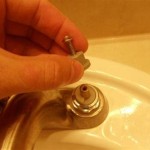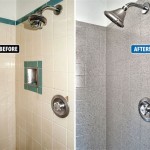What To Use To Seal A Bathroom Sink Drain
A leaky bathroom sink drain can be a significant nuisance, potentially leading to water damage, mold growth, and wasted water. Effectively sealing a bathroom sink drain is crucial for maintaining a functional and water-tight plumbing system. Choosing the right sealant and applying it correctly are essential steps in preventing leaks and ensuring the longevity of your sink and its surrounding areas. This article will provide a comprehensive overview of the materials and techniques used to seal a bathroom sink drain, focusing on the properties, applications, and best practices associated with each approach.
The composition of a bathroom sink drain system typically involves several components that require proper sealing. These components include the drain flange (which sits inside the sink basin), the drainpipe (which connects to the P-trap beneath the sink), and various threaded connections that join these parts together. Each of these connections represents a potential leak point if not properly sealed. The specific sealant required will vary depending on the type of material being joined and the nature of the connection. For instance, sealing the drain flange to the sink basin requires a different approach than sealing threaded pipe connections. Understanding these nuances is crucial for selecting the most effective sealant for the job.
Before commencing any sealing work, it is imperative to properly prepare the surfaces that will be joined. This involves thoroughly cleaning and drying all surfaces to remove any dirt, grime, old sealant, or corrosion. Contaminants can prevent the sealant from adhering properly, resulting in a weak or ineffective seal. For metal surfaces, a wire brush can be used to remove corrosion. For porcelain or ceramic surfaces, a gentle abrasive cleaner can be used to remove stubborn residues. Afterward, wipe down the surfaces with a clean cloth and allow them to dry completely before applying any sealant. Proper surface preparation is a fundamental step toward achieving a durable and leak-proof seal.
Choosing the Right Sealant Type
Several types of sealants are commonly used for sealing bathroom sink drains, each with its own advantages and disadvantages. The most common options include plumber's putty, silicone caulk, Teflon tape (also known as PTFE tape), and pipe dope (also known as pipe joint compound). The selection of the appropriate sealant depends on the specific location of the potential leak and the materials being joined. A careful evaluation of the materials and the type of connection is necessary to determine the optimal sealant for the task.
Plumber's putty is a pliable, clay-like substance that is primarily used to seal drain flanges to the sink basin. It is easy to mold and shape, allowing it to conform to the contours of the drain flange and create a water-tight seal. Plumber's putty remains flexible over time, allowing for slight movement without cracking or losing its seal. It is important to note that plumber's putty is not suitable for threaded connections and should only be used for sealing the drain flange to the sink basin. Its primary function is to create a barrier that prevents water from leaking around the edge of the drain opening.
Silicone caulk is a versatile sealant that provides a durable and waterproof seal. It is available in various colors and formulations, including mildew-resistant options that are particularly suitable for bathroom environments. Silicone caulk is often used to seal the edges of the sink where it meets the countertop, preventing water from seeping behind the sink. It can also be used to seal around the drain flange, although plumber's putty is often preferred for this application due to its ease of use and flexibility. When using silicone caulk, it is important to apply it in a smooth, continuous bead and to tool it properly to ensure a uniform and aesthetically pleasing finish.
Teflon tape is a thin, white tape that is used to seal threaded pipe connections. It is wrapped around the threads of the pipe before the connection is tightened, creating a water-tight seal. Teflon tape works by filling the gaps between the threads and providing lubrication, making it easier to tighten the connection securely. It is a simple and effective way to prevent leaks in threaded connections, such as those found in the drainpipe and P-trap. When applying Teflon tape, it is important to wrap it in the correct direction (clockwise when viewed from the end of the pipe) and to apply enough layers to ensure a good seal. Usually, two to three wraps are sufficient.
Pipe dope is a paste-like compound that is also used to seal threaded pipe connections. It is applied to the threads of the pipe before the connection is tightened, similar to Teflon tape. Pipe dope provides lubrication and helps to fill any gaps between the threads, creating a water-tight seal. Some types of pipe dope are designed to harden over time, creating a more permanent seal. Pipe dope can be used in conjunction with Teflon tape for added security, especially in high-pressure applications. When using pipe dope, it is important to apply it evenly to all of the threads and to avoid getting it on the inside of the pipe, where it could contaminate the water flow.
Applying Sealant to the Drain Flange
The drain flange is a critical component of the bathroom sink drain system, as it forms the connection between the sink basin and the drainpipe. Properly sealing the drain flange is essential for preventing leaks around the sink drain. Whether using plumber's putty or silicone caulk, the application process involves several key steps.
When using plumber's putty, start by rolling a generous amount of putty into a rope-like shape that is long enough to encircle the drain opening on the underside of the drain flange. Press the putty firmly onto the underside of the drain flange, ensuring that it makes full contact with the surface. Position the drain flange into the drain opening in the sink and press down firmly. Tighten the drain flange from underneath the sink, which will squeeze the putty and create a water-tight seal. Any excess putty that squeezes out from around the drain flange can be removed with a putty knife or a clean cloth. It is crucial to ensure that the putty is evenly distributed and that there are no gaps or voids in the seal.
When using silicone caulk to seal the drain flange, apply a bead of caulk around the underside of the drain flange, following the same procedure as with plumber's putty. Ensure that the caulk is applied in a continuous and even bead, and that it makes full contact with the surface. Position the drain flange into the drain opening in the sink and press down firmly. Tighten the drain flange from underneath the sink, which will squeeze the caulk and create a water-tight seal. Wipe away any excess caulk with a damp cloth. It is important to allow the caulk to cure completely before using the sink, as premature use can disrupt the seal and lead to leaks. Refer to the manufacturer's instructions for the recommended curing time.
In either case, after the initial installation, it's advised to check for leaks after running water in the sink. Small adjustments to the tightening of the drain flange can be made to rectify any minor leaks. Leaving the drain assembly undisturbed for the recommended curing time (if using silicone) is important for the sealant to achieve its full bonding strength.
Sealing Threaded Pipe Connections
Threaded pipe connections are commonly found in the drainpipe and P-trap assembly beneath the bathroom sink. These connections provide a means of joining the various components of the drain system together. Proper sealing of these connections is essential to prevent leaks and ensure that the drain system functions correctly.
When using Teflon tape to seal threaded pipe connections, start by cleaning the threads of the pipe with a wire brush to remove any dirt or corrosion. Wrap the Teflon tape around the threads in a clockwise direction (when viewed from the end of the pipe). Overlap each layer of tape slightly to ensure that the threads are fully covered. Apply two to three layers of tape for optimal sealing. After wrapping the tape, tighten the connection securely using a wrench. Avoid over-tightening the connection, as this can damage the threads and compromise the seal.
When using pipe dope to seal threaded pipe connections, apply a thin, even layer of dope to all of the threads of the pipe. Use a brush or your finger to spread the dope evenly. Be careful not to get any dope on the inside of the pipe. Tighten the connection securely using a wrench. Wipe away any excess dope with a clean cloth. Similar to Teflon tape, avoid over-tightening, which can damage the threads. Some plumbers prefer to use both Teflon tape and pipe dope together, applying the tape first and then the dope. This can provide an extra layer of protection against leaks, especially in high-pressure or critical applications.
After assembling the drainpipe and P-trap, it is essential to test the connections for leaks. Run water into the sink and carefully inspect all of the connections for any signs of leakage. If a leak is detected, tighten the connection slightly. If the leak persists, disassemble the connection, reapply the Teflon tape or pipe dope, and reassemble the connection. It may be necessary to replace the Teflon tape or pipe dope if it has been damaged or contaminated. Repeat the testing process until all leaks have been eliminated.

Installing A New Bathroom Sink
How To Seal A Sink Eys
Bathroom Sink Plumbing Installation Diy Montreal

New Bathroom Sink Drain Leaks At Threads

Bathroom Sink Drain Leaking Around Threads Premier Plumbing Inc

Installing A New Bathroom Sink

Vigo Vessel Bathroom Sink Pop Up Drain And Mounting Ring Matte Black Vg07000mb The Home Depot

Bathroom Sink Plumbing Installation Diy Montreal

Stylish Bathroom Sink Pop Up Drain With Overflow Gold D 700g Rona

How To Install A Bathroom Faucet With No Leaks
Related Posts







